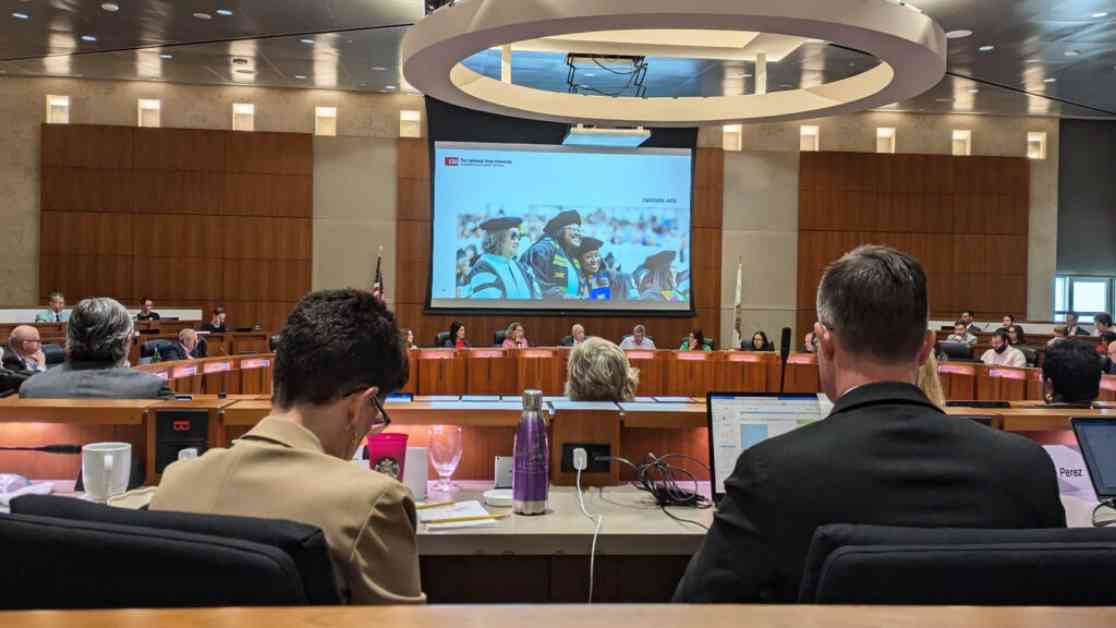California State University (CSU) officials are gearing up for a challenging year ahead as they navigate cost-cutting measures amidst a looming budget gap. The state’s largest university system is facing significant financial pressures, with enrollment declines and rising costs putting a strain on resources.
**Financial Challenges and Budget Gap Forecast**
At a recent meeting of the board of trustees, CSU officials discussed the projected $1 billion budget gap for the 2025-26 school year. Dwindling state support for higher education and rising costs have contributed to the financial challenges facing the university system. To address the budget shortfall, CSU has unveiled plans to reshuffle funds from campuses that fall short of enrollment goals. This includes reallocating $32 million in enrollment funding from 12 campuses to nine campuses where resident enrollment targets have been increased.
CSU Chief Financial Officer Steve Relyea emphasized the need for cost-saving measures to address the financial strain on the university system. Major expenses such as facilities and infrastructure projects, employee compensation costs, and legal obligations under mandates like Title IX are putting pressure on the budget. Relyea highlighted the potential negative impacts on academic offerings and student support services due to budget constraints.
**Enrollment Declines and Cost-Cutting Measures**
Enrollment drops have led to cuts at some CSU campuses, with schools like Cal State Channel Islands, San Francisco State, and Sonoma State experiencing declines in student numbers. Campus leaders have implemented measures such as holding off on filling open positions, launching voluntary separation programs, and making budget cuts to reduce staffing costs. For example, Cal State Monterey Bay announced layoffs and departures to address budget shortfalls, while Cal State East Bay discontinued its women’s water polo program to save money.
Sonoma State University has also implemented cost-cutting measures to manage budget shortfalls. The university has trimmed $21.4 million from its base budget since 2020-21 and plans for an additional $7.5 million cut in 2024-25. These savings have come from reducing faculty and staff numbers through attrition and early retirement programs while maintaining support for student services and academic programs.
**Financial Sustainability and Future Strategies**
CSU Chancellor Mildred García emphasized the importance of pursuing mission-driven efficiency in the face of financial challenges. The Chancellor’s Office is reviewing its divisions to identify opportunities for cost savings while maintaining the university system’s core mission. The board of trustees considered proposals to merge campuses like Cal Maritime into larger institutions like Cal Poly San Luis Obispo to optimize resources and save costs.
Looking ahead, CSU officials are exploring various strategies to address the budget gap and secure financial sustainability. This includes tapping into reserves, aggressively pursuing new student enrollments, and tightening budgets across campuses. While the university system faces uncertainties in state funding and ongoing financial pressures, officials are committed to finding innovative solutions to ensure the long-term financial health of CSU.
**State Funding and Legislative Impact**
The university system’s reliance on state funding poses challenges as legislators anticipate an 8% cut to CSU’s ongoing state funding in the 2025-26 school year. Proposed funding arrangements could strain Cal State’s finances, prompting the need to explore alternative revenue sources and cost-saving measures. CSU leaders have defended decisions to increase tuition and seek philanthropic support to offset ongoing expenses and maintain academic programs and student services.
In conclusion, CSU is navigating a complex financial landscape as it grapples with enrollment declines, budget shortfalls, and rising costs. The university system’s commitment to financial sustainability and strategic planning will be crucial in addressing the challenges ahead and ensuring the continued excellence of higher education in California.
